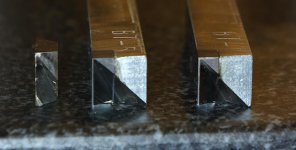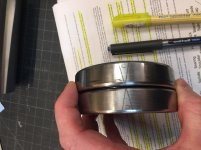I've been trouble shooting a bad surface finish on a Feeler FTS-27 (DSM-59 clone) for a while.
I am currently turning 1/2 brass with about 1.5in of stick out from a 5C collet and I get chatter marks and a consequently undesirable surface finish. I am not able to figure out where the looseness is and how to correct it. Here is what I do know:
1) 1-2 thou of radial play on spindle nose 5c taper (3 high spots (1-2 thou) that I believe correspond to overtightened 5c collets maybe?)
2) a few tenth of needle chatter on the axial runout of the spindle
3) collet closer yoke vibrates - I replaced the bearing, yoke bearing holder spring washers and set screws .. better, but no cigar .. the draw tube dimensions vs. the ID of the spindle are the same as published in another thread and commented on by Larry, IIRC 1.437 vs. 1.438 respectively ..
4) when using a box tool to turn the brass (zero top rake on grind) the work appears to grab the advancement of the tool .. so, the cut is jerky .. after a full dimension forward cut, it cuts more on the back stroke .. so I find myself going back and forth a few times to get a half decent surface finish and a final dimension
so .. is my problem:
a) spindle bearings? (they are completely quiet, don't run warm and axial runout is I think negligible?)
b) bent collet draw tube or misaligned yoke pins?
c) too much stickout? (1.5in in 1/2 brass)
d) is the problem on the turret side maybe? loose gibs? loose turret lock?
e) is it a potential motor or reeves drive vibration that shows up in the work?
f) all of the above
g) none of the above
Hoping to get some insights from you guys,
thanks for your time
best
Mat
I am currently turning 1/2 brass with about 1.5in of stick out from a 5C collet and I get chatter marks and a consequently undesirable surface finish. I am not able to figure out where the looseness is and how to correct it. Here is what I do know:
1) 1-2 thou of radial play on spindle nose 5c taper (3 high spots (1-2 thou) that I believe correspond to overtightened 5c collets maybe?)
2) a few tenth of needle chatter on the axial runout of the spindle
3) collet closer yoke vibrates - I replaced the bearing, yoke bearing holder spring washers and set screws .. better, but no cigar .. the draw tube dimensions vs. the ID of the spindle are the same as published in another thread and commented on by Larry, IIRC 1.437 vs. 1.438 respectively ..
4) when using a box tool to turn the brass (zero top rake on grind) the work appears to grab the advancement of the tool .. so, the cut is jerky .. after a full dimension forward cut, it cuts more on the back stroke .. so I find myself going back and forth a few times to get a half decent surface finish and a final dimension
so .. is my problem:
a) spindle bearings? (they are completely quiet, don't run warm and axial runout is I think negligible?)
b) bent collet draw tube or misaligned yoke pins?
c) too much stickout? (1.5in in 1/2 brass)
d) is the problem on the turret side maybe? loose gibs? loose turret lock?
e) is it a potential motor or reeves drive vibration that shows up in the work?
f) all of the above
g) none of the above
Hoping to get some insights from you guys,
thanks for your time
best
Mat




